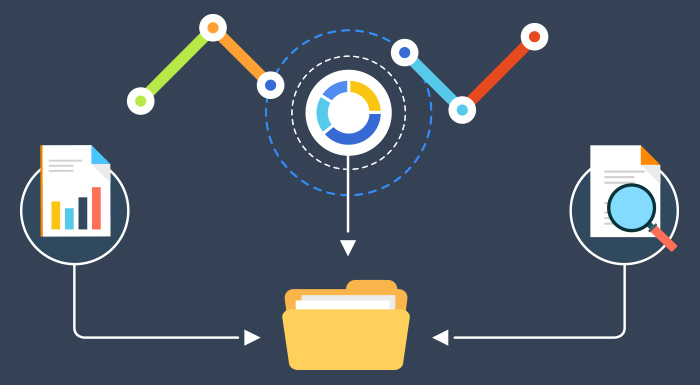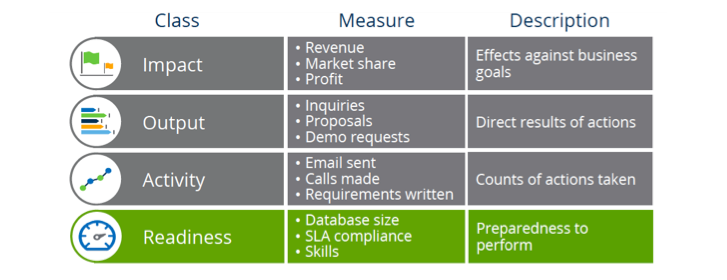Ready, Set, Metrics: A New Approach to Marketing Measurement

Does this sound familiar? You’ve spent months preparing and launching a new integrated marketing program. Everything seems to be going smoothly … until management asks to see your results. Suddenly, you’re scrambling. There are so many different marketing measurements. How do they work together, and which really show the impact you’ve had on your business?
We hear from B2B marketers who run into measurement problems all the time. The proof’s in the numbers: Only 44% of CMOs can adequately measure ROI, and 74% of marketers can’t measure how their programs contribute to their business.
Often, these measurement problems start with a key area marketers aren’t including in their calculations: marketing readiness.
A measurement framework for modern marketers
To frame our measurement discussion, take a look at the SiriusDecisions Aligned Measurement Framework below. It breaks measurement into four pillars — and the most important one is impact. That’s your holy grail: the effect you have on revenue, market share and business goals.

Many marketers don’t get that far, though. They only measure output, or the direct results of marketing programs. Or they just measure activity: day-to-day actions taken because of marketing. Maybe they measure a combination of both. But here’s the catch: Output and activity only tell you how your marketing is performing. They won’t tell you why. They don’t reveal what opportunities you might be missing, or why your impact isn’t as strong as you want. That’s where marketing readiness comes in.
Marketing readiness is a measure of your ability to have a positive impact on your business. In other words, it measures how prepared you are to perform well. It evaluates your operational foundation, and reveals problems that are keeping you from having a bigger impact.
So how can you measure readiness? There are many factors to consider, and each marketing operation is different. You could consider your readiness in terms of technology, operations, your agency, supplier base, and more. The three areas below, however, are a great place to start.
Readiness area 1: database health
When it’s managed well, your database is a gold mine of buyer insight: who they are, what they want, how they want you to engage with them. But a badly managed database can be more of a headache than a help.
If your database doesn’t have enough records — or if your records aren’t complete, accurate and segmented — your programs will be limited from the start. This sacrifices potential reach and engagement, and your metrics will reflect that.
To get your data ready for action, evaluate your database health on a regular basis. Supplementing, cleaning and maintaining your database will result in better data to power your programs, and a bigger impact at the end of the day.
Readiness area 2: service-level agreements
We think of a service-level agreement (SLA) as a sales and marketing road map. These written contracts define shared agreements and expectations for your sales and marketing teams, and they’re a key step toward marketing readiness.
How will Sales and Marketing approach lead nurturing? Who’s responsible for what? How will teams be held accountable? A good SLA includes those answers. Without one, balls will be dropped, and miscommunication will damage your impact.
If your company’s SLA is gathering dust, now’s the time to put it back into action. (Don’t have an SLA? This ebook will get you started.)
Readiness area 3: skills and resources
Having the right resources in place doesn’t just mean making great hires — although that matters too! It also means having the right technology foundation to deploy modern marketing programs. This begins by defining which job roles will be responsible for the design, execution and management of those programs. Then, adding the right processes will make the operations really work.
As you evaluate your marketing readiness, audit your team. If you find holes, consider whether hiring or outsourcing is the best way to fill them. Getting the right skills takes an upfront investment, but the benefits are more than worth it. Then, ensure you have the tech and processes in place to make your team successful.
Results that matter
Measuring readiness is a new idea for many marketers. But if you can evaluate and improve yours, you’ll see better metrics at every level. You’ll increase activity and output. Most importantly, you’ll improve your business impact: qualified lead counts, revenue, market share, profit.
Next time management asks for metrics, you’ll be proud of what you have to show. And importantly, you’ll be able to show progress as you improve your readiness, and measure where you are on your journey. After all, nobody can flip a switch and make all changes at once. With the right metrics — readiness included — you’ll be in control of your transformation story.